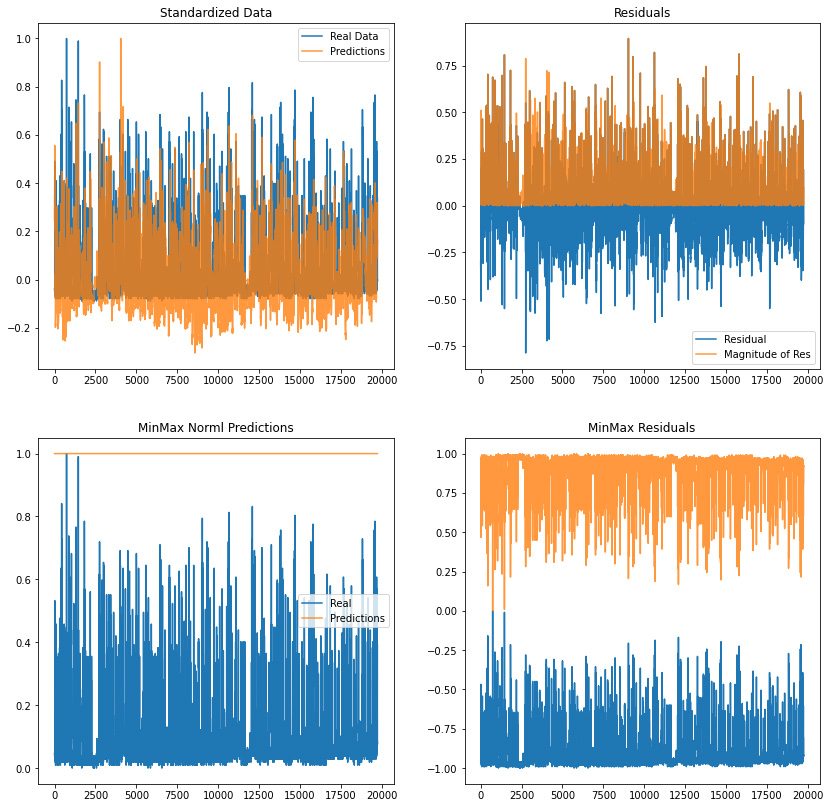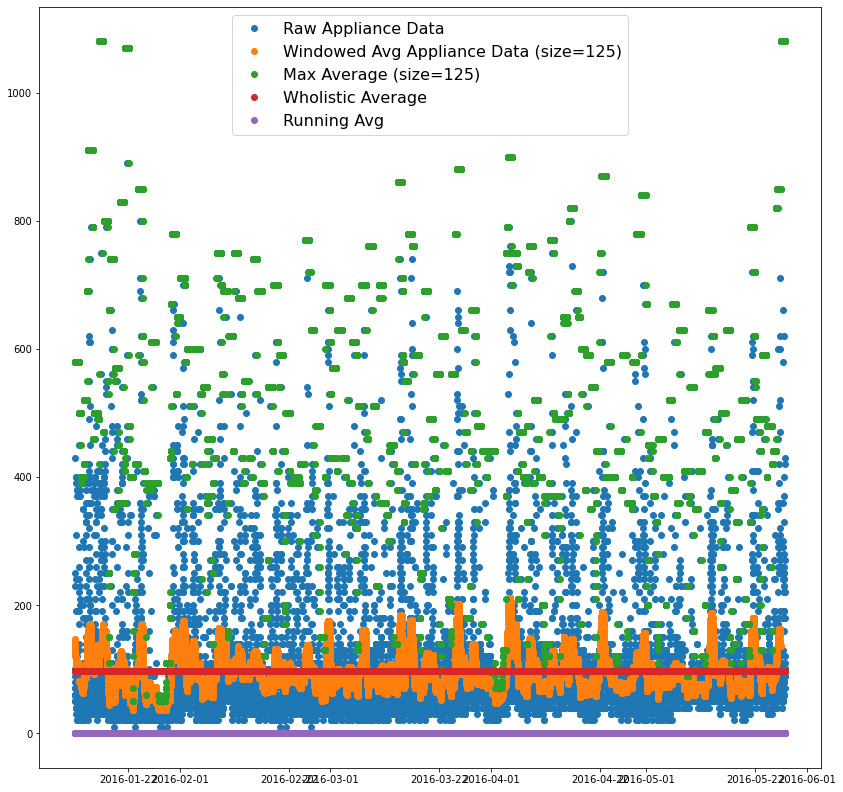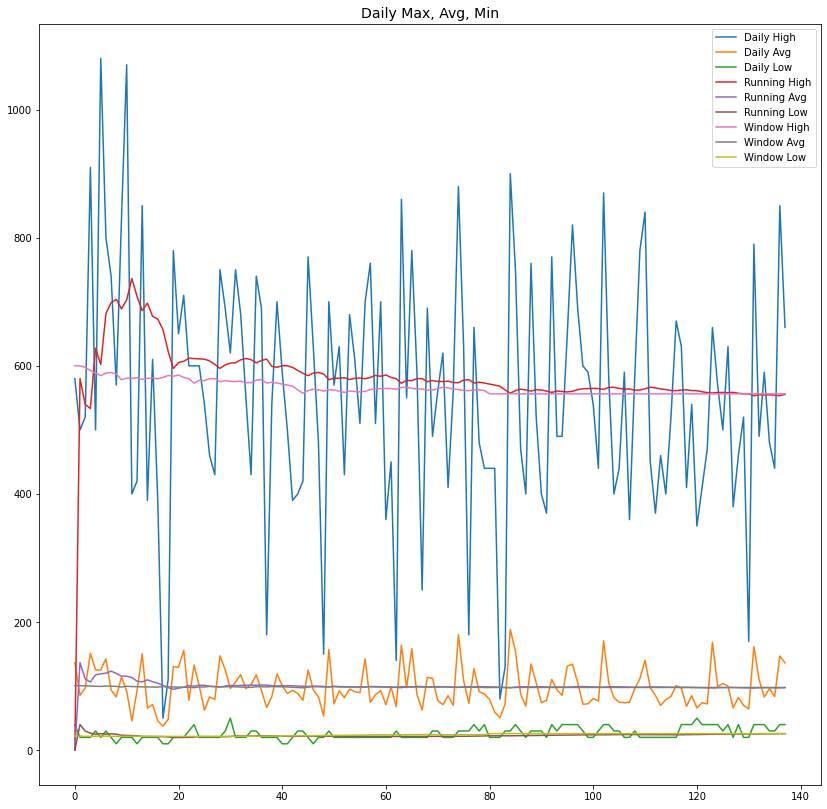Suggest a Dataset
Introduction
As part of my capstone, I am analyzing PHM datasets. I choose UCI's Applicance energy prediction data set. From their website:
The data set is at 10 min for about 4.5 months. The house temperature and humidity conditions were monitored with a ZigBee wireless sensor network. Each wireless node transmitted the temperature and humidity conditions around 3.3 min. Then, the wireless data was averaged for 10 minutes periods. The energy data was logged every 10 minutes with m-bus energy meters. Weather from the nearest airport weather station (Chievres Airport, Belgium) was downloaded from a public data set from Reliable Prognosis (rp5.ru), and merged together with the experimental data sets using the date and time column. Two random variables have been included in the data set for testing the regression models and to filter out non predictive attributes (parameters).
import numpy as np
import matplotlib
import matplotlib.pyplot as plt
import pandas as pd
from datetime import datetime
import seaborn as sns
import sklearn
Downloading Data
## REPLACE WITH PYTHON CLIENT EVENTUALLY
import requests
def save_file(url, file_name):
r = requests.get(url)
with open(file_name, 'wb') as f:
f.write(r.content)
save_file('https://archive.ics.uci.edu/ml/machine-learning-databases/00374/energydata_complete.csv',
'energy_data.csv')
First Model
from sklearn import preprocessing
data = pd.read_csv('energy_data.csv')
dataColumns = []
for name in data:
dataColumns.append(name)
features = dataColumns.copy()
features.remove('date')
features.remove('Appliances')
# Mean Normalization
meanNormData = data.copy()
meanNormData = data.drop(['date'], axis=1)
meanNormData = (meanNormData - meanNormData.mean()) / meanNormData.std()
# Min-Max Normalization
MinMaxNorm = data.copy()
MinMaxNorm = MinMaxNorm.drop(['date'], axis=1)
MinMaxNorm = (MinMaxNorm - MinMaxNorm.min()) / (MinMaxNorm.max() - MinMaxNorm.min())
from sklearn import linear_model
from sklearn import metrics
# Training the Mean Normalized Data
modelLASSO = linear_model.Lasso(alpha=0.01)
modelLASSO.fit(meanNormData[features], meanNormData['Appliances'])
ypred = modelLASSO.predict(meanNormData[features])
standardData = meanNormData['Appliances'] / max(meanNormData['Appliances'])
standardPred = ypred / max(ypred)
# Training the MinMax Data
newLasso = linear_model.Lasso(alpha=0.01)
newLasso.fit(MinMaxNorm[features], MinMaxNorm['Appliances'])
MinMaxPred = newLasso.predict(MinMaxNorm[features])
MinMaxData = MinMaxNorm['Appliances']
# # Normalize for Percentage
MinMaxData = MinMaxNorm['Appliances'] / max(MinMaxNorm['Appliances'])
MinMaxPred = MinMaxPred / max(MinMaxPred)
# Error -----------------------------------------------------------------------
standardError = sklearn.metrics.mean_squared_error(standardData, standardPred)
minmaxError = sklearn.metrics.mean_squared_error(MinMaxData, MinMaxPred)
print("Standard Error: ", standardError)
print("MinMax Error: ", minmaxError)
# Makes sense. Seasonality stuff makes MinMax off
# Plotting ---------------------------------------------------------------------
plt.figure(figsize=(14, 14))
plt.subplot(2,2,1)
plt.plot(standardData)
plt.plot(standardPred, alpha=0.8)
plt.title("Standardized Data")
plt.legend(['Real Data', 'Predictions'])
plt.subplot(2,2,2)
plt.plot(standardData - standardPred)
plt.plot(abs(standardData - standardPred), alpha=0.8)
plt.title('Residuals')
plt.legend(['Residual', 'Magnitude of Res'])
plt.subplot(2,2,3)
plt.plot(MinMaxData)
plt.plot(MinMaxPred, alpha=0.8)
plt.title('MinMax Norml Predictions')
plt.legend(['Real', 'Predictions'])
plt.subplot(2,2,4)
plt.plot(MinMaxData - MinMaxPred)
plt.plot(abs(MinMaxData - MinMaxPred), alpha=0.8)
plt.title('MinMax Residuals')
Standard Error: 0.019117543021155804
MinMax Error: 0.8519818461945436
Text(0.5, 1.0, 'MinMax Residuals')

Analysis
From previous exploration, mean normalizing improve the model. I assume this is the case as the weather is not too volatile in California.
Looks good enough to me, however, this is predicting training data. Can we reproduce results with a test data set?
# Splitting Data
from sklearn.model_selection import train_test_split
featureData = meanNormData[features]
labelData = meanNormData['Appliances']
train_features, test_features, train_labels, test_labels = train_test_split(featureData, labelData, test_size=0.33)
from sklearn import linear_model
from sklearn import metrics
lassoModel = linear_model.Lasso(alpha=0.01)
lassoModel.fit(train_features, train_labels)
predictions = lassoModel.predict(test_features)
standardLabels = test_labels / max(test_labels)
standardPred = predictions / max(predictions)
standardError = sklearn.metrics.mean_squared_error(standardLabels, standardPred)
print("Standard Error: ", standardError) # not great.
Standard Error: 0.02092424973882732
Analysis
Looks like it won't be that simple lol. Mean normalization improved the model by < 0.01
Data Exploration
all_dates_string = data['date']
all_dates = []
for date_string in all_dates_string:
all_dates.append( datetime.strptime(date_string, "%Y-%m-%d %H:%M:%S") )
plotting_dates = matplotlib.dates.date2num(all_dates)
# ------------------------
# DAILY
# ------------------------
# STOPS AT 20,000
counter = 1
dateKeys = []
date_map = {}
for date in all_dates:
day = str(date.day)
if int(str(date.day)) < 10:
day = "0" + str(date.day)
currString = str(date.year) + "-0" + str(date.month) + "-" + day
if currString not in date_map:
currDF = data.loc[data['date'].str.contains(currString, case=False)]
date_map[currString] = currDF
dateKeys.append(currString)
counter = counter + 1
if (counter % 1000 == 0):
print('Count at: ', counter)
appliance_data = data['Appliances'].to_numpy()
#20,000 samples, average every 100
avg_app_data = np.zeros(len(appliance_data))
averging_size = 125
max_average = np.zeros(len(appliance_data))
running_avg = np.zeros(len(appliance_data))
for i in range(0, len(appliance_data)):
if (i < averging_size):
temp = appliance_data[0:i+50]
elif (i > (len(appliance_data) - averging_size)):
temp = appliance_data[-(i+averging_size):]
else:
half = int(averging_size/2)
temp = appliance_data[i-half:i+half]
max_average[i] = max(temp)
temp = sum(temp) / len(temp)
avg_app_data[i] = temp
n = len(appliance_data)
applianceFFT = np.fft.fft(appliance_data)
w = [(2*np.pi)/(np.pi*n)*i for i in range(0, n)]
FFTfreq = np.fft.fftfreq(n)
average_value = np.mean(appliance_data)
print(average_value)
plt.figure(figsize=(14,14))
plt.plot_date(plotting_dates, appliance_data)
plt.plot_date(plotting_dates, avg_app_data)
plt.plot_date(plotting_dates, max_average)
plt.plot_date(plotting_dates, np.ones(len(appliance_data))*average_value)
plt.plot_date(plotting_dates, running_avg)
plt.legend(['Raw Appliance Data', 'Windowed Avg Appliance Data (size=125)', 'Max Average (size=125)', 'Wholistic Average', 'Running Avg'], fontsize=16)
97.6949581960983
<matplotlib.legend.Legend at 0x7fb9a14910d0>

index = 0
numKeys = len(dateKeys)
daily_high = np.zeros(numKeys)
daily_avg = np.zeros(numKeys)
daily_low = np.zeros(numKeys)
for d in dateKeys:
currDay = date_map[d]
currAppliance = currDay['Appliances'].to_numpy()
daily_high[index] = max(currAppliance)
daily_avg[index] = np.mean(currAppliance)
daily_low[index] = min(currAppliance)
index = index + 1
# Running averages
running_high = np.zeros(numKeys)
running_avg = np.zeros(numKeys)
running_low = np.zeros(numKeys)
for i in range(1, numKeys):
running_high[i] = np.convolve(daily_high[0:i], np.ones(i)/i, mode='valid')
running_avg[i] = np.convolve(daily_avg[0:i], np.ones(i)/i, mode='valid')
running_low[i] = np.convolve(daily_low[0:i], np.ones(i)/i, mode='valid')
# Windowed
window_size = 80
window_high = np.zeros(numKeys)
window_avg = np.zeros(numKeys)
window_low = np.zeros(numKeys)
for i in range(0, numKeys):
half = int(window_size/2)
if (i < window_size):
temp_high = daily_high[0:i+half]
temp_avg = daily_avg[0:i+half]
temp_low = daily_low[0:i+half]
elif (i > (len(daily_high) - window_size)):
temp_high = daily_high[-(i+window_size):]
temp_avg = daily_avg[-(i+window_size):]
temp_low = daily_low[-(i+window_size):]
else:
temp_high = daily_high[i-half:i+half]
temp_avg = daily_avg[i-half:i+half]
temp_low = daily_low[i-half:i+half]
window_high[i] = sum(temp_high) / len(temp_high)
window_avg[i] = sum(temp_avg) / len(temp_avg)
window_low[i] = sum(temp_low) / len(temp_low)
plt.figure(figsize=(14,14))
plt.plot(daily_high)
plt.plot(daily_avg)
plt.plot(daily_low)
plt.plot(running_high)
plt.plot(running_avg)
plt.plot(running_low)
plt.plot(window_high)
plt.plot(window_avg)
plt.plot(window_low)
plt.title('Daily Max, Avg, Min', fontsize=14)
plt.legend(['Daily High', 'Daily Avg', 'Daily Low','Running High', 'Running Avg', 'Running Low', 'Window High', 'Window Avg', 'Window Low'])
<matplotlib.legend.Legend at 0x7fb99fdbffd0>

